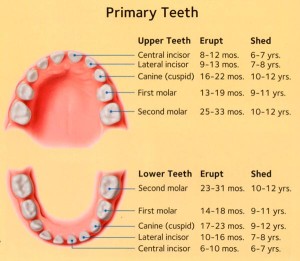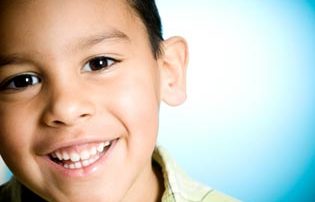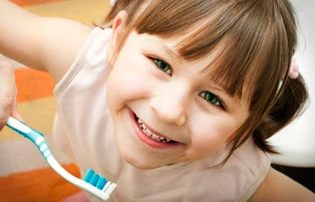Primary Teeth
 Your child’s baby teeth help your child chew and speak normally. They also hold space in the jaws for the adult teeth that come in later. Starting infants with good oral care can help protect their teeth for decades to come.
Your child’s baby teeth help your child chew and speak normally. They also hold space in the jaws for the adult teeth that come in later. Starting infants with good oral care can help protect their teeth for decades to come.
A baby’s teeth start to come in when the baby is about six months old. By age three, most children have a full set of 20 primary teeth. Baby teeth will later be lost as your child develops and grows. This makes space for adult (permanent) teeth, which begin to come in around age 6.
The chart above tells the names of baby (primary) teeth. It also shows when each tooth usually erupts and is shed. However, not all children get the same teeth at the same times. Your child’s teeth may erupt earlier or later than shown here.
Permanent Teeth
 At about age five or six, children begin to lose their top and bottom front teeth, called the incisors. Between ages six and 12, they will usually lose all 20 primary teeth. By the age of 21, up to 32 permanent teeth will come in to replace them.
At about age five or six, children begin to lose their top and bottom front teeth, called the incisors. Between ages six and 12, they will usually lose all 20 primary teeth. By the age of 21, up to 32 permanent teeth will come in to replace them.
The first permanent teeth usually come in between ages six and seven. These big, bumpy teeth at the back of the mouth are called molars. After this, your child will have a mix of primary and permanent teeth for a while. During this time the smile can look a little uneven, with some big teeth, some small teeth and even some missing teeth. But try not to worry. Things often even out once all the permanent teeth are in place.
The chart above tells the names of adult teeth. The pictures show when each tooth usually comes in. However, not all children get the same teeth at the same times. Your child’s teeth may erupt earlier or later than these charts.











